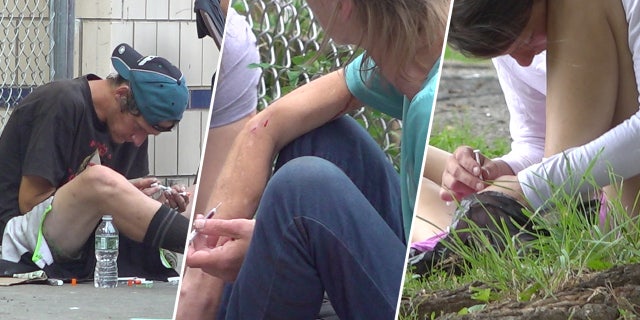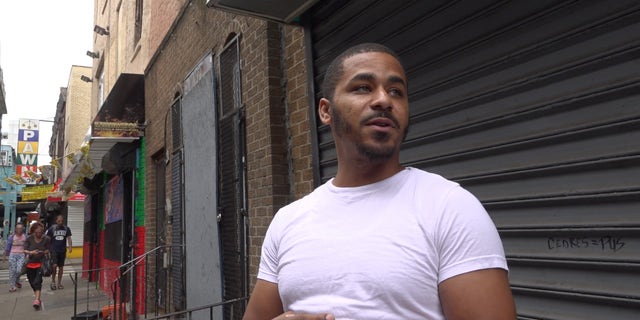WARNING: This story contains graphic images.
PHILADELPHIA — Kensington has for years been a haven where addicts could freely shoot heroin. But as stronger substances like fentanyl and tranq, the flesh-easting drug, took hold, the neighborhood devolved further into a full-on deathbed and a hotspot for crime, current and former residents told Fox News.
“At one point, it was a drug haven, a place where people could come and get high, where they’re not going to be judged,” said Frank Rodriguez, a recovering heroin addict who dealt drugs in Kensington. “It went from being a place where people got high to—you know, you look around and you see skin and bones.”
HOW THIS DRUG HAVEN GOT ‘DRAMATICALLY WORSE,’ ACCORDING TO A FORMER RESIDENT
WATCH MORE FOX NEWS DIGITAL ORIGINALS HERE
“I’ve seen it get dramatically worse,” he continued. “I see suffering. I see a lot of hurt. I see a lot of pain.”
Kensington has become a worldwide focal point for excessive public drug consumption, showcasing worsening effects from deadly substances like tranq infiltrating the illicit drug supply. The neighborhood was already known for its drug use, but even more addicts line the sidewalks in recent years and now are often covered in drug-induced flesh-eating wounds.
One gloomy August afternoon on Kensington Avenue, concerned helpers checked pulses and nudged users who were sprawled out across the sidewalk in a trance.
Dozens of drug users are scattered across Kensington Avenue. Many were either injecting themselves with needles or were passed out on the sidewalk. (Jon Michael Raasch/Fox News Digital)
“You see people with sores, and you see parts of the body you’re not supposed to see that are exposed because of the infections,” Rodriguez said. “You smell the rotting flesh when you walk down the block. It’s hell on earth.”
At first, heroin plagued the drug-ridden Kensington community, then fentanyl. Now, the neighborhood is ground zero for the latest craze, xylazine, an addictive veterinary tranquilizer that literally eats away users’ flesh.
The drug — known as the zombie drug or tranq — was found in over 90% of drug samples tested in Philadelphia in 2021, according to city data. As Rodriguez walked through Kensington’s open-air drug market in August, several tranq users with scabbing or oozing gashes covered in fleas were spotted.

Tranq users, who sometimes unknowingly take the drug, can get painful flesh-eating wounds among other detrimental effects from the potentially lethal substance. (Megan Myers/Fox News Digital)
“The product is getting worse,” said Britt Carpenter, director of The Philly Unknown Project, a local nonprofit providing resources to homeless people. “The quality of the product is getting worse because they know that they’re hooked, and they know that’s where they can keep them.”
OVERDOSES CONTINUE TO FUEL SALES FOR THE SACKLERS — THE FAMILY ACCUSED OF IGNITING THE OPIOID CRISIS
Carpenter spends hours each week wheeling a cart full of snacks, clothes and hygienic supplies. But the nonprofit director said the neighborhood has continued to deteriorate due to a lack of empathy from residents and government officials, deadlier substances entering the drug supply and a growing homeless population.
“It’s gotten worse on many different levels,” Carpenter said. “It’s become such a large population out there that it’s sometimes uncountable because it’s just untraceable.”

A local nonprofit director, Britt Carpenter, wheels around snacks and water to give to struggling drug users on the streets of Kensington. (Megan Myers/Fox News Digital )
Carpenter said a growing number of drug users have died from overdoses. He gave a eulogy earlier this month for a friend of his who was found dead slumped over on Kensington Avenue.
“They’re not really sure how long he was there because people just walk by,” he said. “It could have been a day, could’ve been two days.”
“It’s not my first, and it probably won’t be my last,” he continued. “There is a lot of people out here that we’ve lost.”
Pennsylvania was among the top 10 states with the highest overdose death rates in 2021, according to the Centers for Disease Control and Prevention. Drug overdose mortality hit a record-high of 5,449 deaths across the state, up nearly 25% since 2019.
Philadelphia, in particular, had nearly 1,300 unintentional overdose deaths in 2021, with over 80% involving opioids like fentanyl or heroin, according to city data.
“That could be your brother, your sister, your neighbor or your mother,” Carpenter, a recovering addict himself, said. “Your father could be there on the street one day. I know that firsthand that I used to always say ‘that’ll never be me.'”

Dozens of drug users shoot up on Kensington Avenue or in McPherson Park, otherwise known as needle park. Blood trickles down one woman’s arm after she injected herself. (Megan Myers/Fox News Digital)
Rodriguez, a fellow recovering addict, shared that empathy. Both former users left Kensington and routinely visit to humanize and assist victims of substance use disorder.
But Rodriguez said the increased public drug use has led to more crime in the area as users look for ways to feed their habit.
WHAT THIS DRUG-RIDDEN COMMUNITY LOOKS LIKE ON AN SUMMER AFTERNOON. WATCH:
“You’re going to get shoplifting, you’re going to get violent crimes, you’re going to get robberies, you’re going to get people carjacking,” Rodriguez said. “Then one of the saddest things you’re going to find for the females is you’re going to find them exploiting themselves, selling their bodies.”
One lifelong Kensington resident, Rob, similarly said the neighborhood has gotten more dangerous. He told Fox News he was bringing pizza home for his kids to avoid exposing them to criminals and drug addicts.

A lifelong Kensington resident loves his community, but fears the dangers that the rampant public drug use has caused in luring criminals to their area. He says he’s scared to bring his kids out on the streets. (Megan Myers/Fox News Digital)
CRISIS IN KENSINGTON: WHERE CHILDREN REGULARLY STEP OVER BODIES TO GET TO SCHOOL
“2015 and up, it just got real bad,” Rob said. “I do not let my daughter come out the car out here, and it’s just for a lot of reasons … needles, guns, drug addicts, fights, disrespect, no hospitality, no nothing.”

Two men brawl on the Kensington Avenue sidewalk as Rodriguez tries to break up the fight. Bystanders watch like it’s a normal summer afternoon. (Megan Myers/Fox News Digital)
CLICK HERE TO GET THE FOX NEWS APP
The neighborhood’s violent crime rate was over 30% higher than the rest of the city between 2012 and 2016, according to a Drexel University study. More recently, Kensington had among the worst violent and drug crime rates citywide over the last month, data compiled by The Philadelphia Inquirer showed.
“This will 100% spread like wildfire,” Rodriguez said about the rampant drug use and crime that’s taken over Kensington. “It’s going to get worse before it gets better.”
Click the link to learn more about Philadelphia’s open-air drug market.